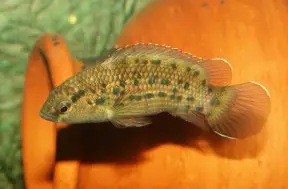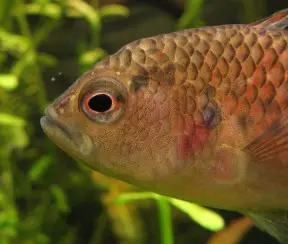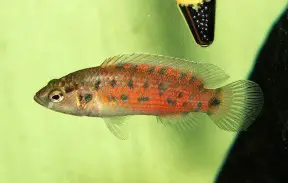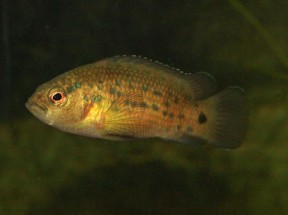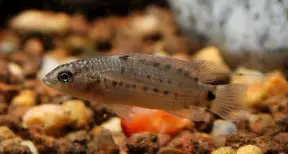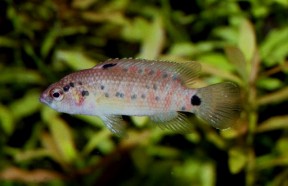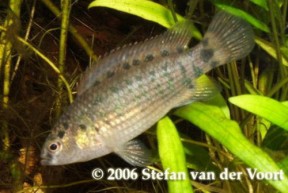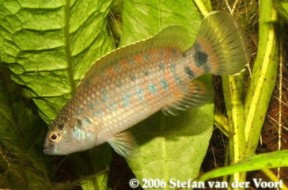Badis assamensis
Classification
Order: Perciformes Family: Badidae
Distribution
The full extent of its range remains somewhat unclear. It was first thought to be endemic to the Brahmaputra River basin in Assam state, northeast India but may also occur in northern West Bengal close to the border with Assam. During research for their 2002 revision of the genus Kullander and Britz were unable to locate any type specimens in museum records and therefore designated a neotype which was collected from a tributary of the Dibru River in Dibrugarh District, northern Assam. The Dibru used to feed the Brahmaputra prior to the 1950 Assam-Tibet earthquake.
Habitat
The neotype locality is a slow-moving stream that flows through a forested area with trees growing down to the banks and into the water in some cases. The water is described as “stagnant” and “brownish”with a substrate of sand in which beds of waterlilies grow. B. badis was also found at the locality.
Maximum Standard Length
This is the largest species in the genus and can grow to 65 – 75 mm.
Aquarium SizeTop ↑
A single pair or small group can be housed in a tank with a base measuring 75 ∗ 30 cm or more.
Maintenance
B. assamensis will thrive in a well-structured set-up with a sand or gravel substrate plus plenty of water-worn rocks and pebbles to provide cover. Plant species that can be grown attached to the decor such as Microsorum, Taxiphyllum or Anubias species can be added if you wish but aren’t essential. Driftwood twigs, branches, floating plants and leaf litter can also be used to lend a more natural feel while filtration and lighting need not be too strong. Some cave-like structures should be included to act as potential spawning sites; many breeders use half-coconut shells or up-turned clay plant pots with drilled holes or parts of the rim removed to allow the fish access.
Water Conditions
Temperature: This species is subject to seasonal temperature fluctuations in nature and is comfortable between 15 – 25 °C with even greater extremes being tolerated for short periods. In many countries/well-insulated homes it can be therefore maintained without artificial heating year-round. Temperatures towards the upper end of this range are known to stimulate spawning activity meaning a heater will be required if you want to breed the fish outside of spring and summer months though. Set it to around 68 – 75?°F/20 – 24?°C for long-term care and breeding.
pH: Does best in slightly acidic to neutral water with a value of 6.0 – 7.5.
Hardness: 54 – 179 ppm
Diet
Badis species are micropredators feeding on small aquatic crustaceans, worms, insect larvae and other zooplankton. They can be a little picky in the aquarium and may not accept dried foods although in some cases they will learn to take them over time. At any rate they should always be offered regular meals of small live or frozen fare such as Artemia, Daphnia or glassworm in order to develop ideal colour and conditioning. They’re somewhat shy, deliberate feeders (see ‘compatibility’) and it’s also important to note that all species develop issues with obesity and become more susceptible to disease when fed chironomid larvae (bloodworm) and/or Tubifex so these should be omitted from the diet.
Behaviour and CompatibilityTop ↑
Can be kept in a community tank provided tankmates are chosen with care. It is slow-moving with a retiring nature and may be intimidated or outcompeted for food by larger/more boisterous tankmates while very small fish may be predated upon. Peaceful, schooling cyprinids make good choices as do most gouramis because these tend to inhabit the upper parts of the tank. Accommodating it in a biotope-style community of Assamese fish is more tricky although suitable species from the region include Pethia gelius, Parambassis ranga, Colisa lalia and C. chuna. Certainly do not combine it with similar-looking, territorial bottom dwellers such as dwarf cichlids unless the tank is very large and never house it with other Badis species as hybridisation might occur. Also note that freshwater shrimp of the popular genera Caridina and Neocaridina, and certainly their young, may be preyed upon.
It is not a gregarious fish and rival males can be very aggressive towards one another, especially in smaller tanks. In these cases only a single pair or one male and several females should be purchased but in roomier surroundings a group can coexist provided there is space for each male to establish a territory and plenty of broken lines of sight. The clever placement of caves can help enormously in this respect; do not be tempted to cluster all the available spawning sites in one area of the tank, for example.
Sexual Dimorphism
Females are smaller, have duller patterning and a noticeably shorter, rounder-looking body profile then males. Males also develop slightly extended finnage as they mature.
Reproduction
Members of this genus are cave spawners that form temporary pair bonds and are not usually too difficult to breed provided the tank is arranged correctly (see ‘tank set-up’). Other species are best omitted if you want to raise good numbers of fry although in a mature, well-furnished community a few may survive to adulthood. Either a single pair or a group of adults can be used but if using multiple males be sure to provide each with a cave to defend. Water parameters should be within the values suggested above. Feed the fish with plenty of live and frozen foods and spawning should not present too many problems.
As they come into breeding condition rival males will become increasingly combative and begin to display courtship behaviour towards females entering their chosen territory. During this process they display some wonderful changes in patterning with the body intensifying in colour. The locking of mouths is also common; the male literally attempting to drag his partner into the cave. A receptive female will enter and spawning takes place with usually 30-100 eggs being laid.
Post-spawning the female is ejected and the male takes sole responsibility for the eggs and fry, defending the territory against intruders and fanning the brood with his fins. If you wish the other adult fish can be removed at this point although it is not absolutely necessary yet. The eggs usually hatch in 2-3 days but the fry do not become free swimming until they are 6-8 days old and may not leave the vicinity of the cave for another week or so after that. From then the adults (parent male included) may begin to regard them as food and are best transferred to a separate tank. The young fish are quite sedentary for the first few days meaning microworm is the ideal initial food but once they are visibly swimming in the water column Artemia nauplii can be introduced to the diet.
NotesTop ↑
Like most badids this species is poorly documented and has yet to find significant popularity in the aquarium hobby. It is easily confused with B. blosyrus at first glance as the body patterning of the two is almost identical but can be distinguished by its slightly larger adult size, noticeably shorter jaw profile and some other, mostly internal, meristic characters.
Prior to 2002 the family Badidae included just five species of which only B. badis and, to a lesser extent, Badis dario (referred to as B. bengalensis by some sources) were popular in the aquarium hobby. However an extensive revision paper by Kullander and Britz released that year resulted in the erection of no less than ten new species along with the genus Dario into which B. dario was moved and designated the type species. Dario currently contains only three members which are most easily distinguished from Badis by their small adult size (usually less than 1″/2.5cm), predominantly red colouration, extended first few dorsal rays/pectoral fins in males, straight-edged (vs. rounded) caudal fin, lack of visible lateral line and less involved parental behaviour. Badis species now number fifteen with several new ones described recently and others awaiting description.
Some of them are not always easy to identify correctly. For example B. badis, B. chittagongis, B. ferrarisi, B. kanabos, B. khwae, B. ruber, B. siamensis and B. tuivaiei all exhibit a dark cleithral spot just above the base of the pectoral fin. However B. khwae, B. ruber and B. siamensis all have an additional blotch on the caudal peduncle, and B. badis can be told apart from B. kanabos by possessing a series of dark markings in the dorsal fin and/or at its base (vs. a single marking at the front of the fin) and only faint or indistinct vertical bars on the flanks (vs. a series of dark narrow bars). B. badis, B. chittagongis, B. dibruensis, B. tuivaiei and B. ferrarisi only differ in some morphological counts although the latter has very distinctive patterning, displaying a series of black vertical bars along the centre of the flanks.
Badids have historically been considered members of the families Nandidae or Pristolepididae and it was not until 1968 that Barlow proposed a separate grouping for them. They share some characteristics with anabantoids, nandids and channids; most notably for aquarists the typical spawning embrace in which the male wraps his body around that of the female. More recent studies have concluded that this procedure is an ancient trait inherited from a common ancestor to all these families. In the 2002 revision paper all Badis, Dario and Nandus species were found to share a uniquely bifurcated (split) hemal spine on the penultimate vertebra and the authors hypothesise that this may represent evidence of the monophyly of this group. They further propose that the family Nandidae should be restricted to include only Nandus species with the other genera (Polycentrus, Monocirrhus, Afronandus and Polycentropsis) grouped together in Polycentridae. Following this system the Nandidae and Badidae are only separated by differences in morphology and egg structure although the phylogenetic relationships between them are yet to be fully-studied.
These recent studies have also shown that there exist several groups/clades within the genus, each containing species that are most closely-related to one another. The B. badis group is distinguished only by the cleithral spot and contains B. badis, B. chittagongis, B. dubruensis, B. ferrarisi, B. kanabos and B. tuivaiei. B. ruber, B. siamensis and B. khwae comprise the B. ruber group and are most easily identified by the combination of cleithral spot plus caudal peduncle blotch. The B. assamensis group consists of B. assamensis and B. blosyrus with a unique body pattern of light and dark striping while the B. corycaeus group includes B. corycaeus and B. pyema which possess an ocellated marking at the base of the caudal fin along with a reduction in the number of sensory pores on the head.
There are two unique species which don’t fit into any of these groups; B. kyar is separated by its relatively elongated body shape, pattern of vertical barring and band-like caudal fin marking; B. juergenschmidti is similar to B. kyar in some respects but the first vertical body bar is straight (vs. curved), vertical bars 5, 6 and 7 are solid (vs. vertically split) and the dorsal and lower caudal fin lobe are edged in white in males (vs. no white patterning). In the phylogenetic study B. kyar was found to represent the sister group to either the B. ruber or B. badis/B. assamensis clades depending on the test performed and further studies are required to determine the exact placement of these two within the genus.
References
- Geetakumari, K.H. and W. Vishwanath. 2010 - Journal of Threatened Taxa 2(1): 644-647
Badis dilbruensis, a new species (Teleostei: Badidaae) from northeastern India. - Kullander, S.O. and R. Britz. 2002 - Ichthyological Exploration of Freshwaters 13(4): 295-372
Revision of the family Badidae (Teleostei: Perciformes), with description of a new genus and ten new species. - Rüber, L., R. Britz, S. O. Kullander and R. Zardoya. 2004 - Molecular Phylogenetics and Evolution 32(3): 1010-1022
Evolutionary and biogeographic patterns of the Badidae (Teleostei: Perciformes) inferred from mitochondrial and nuclear DNA sequence data. - Schindler, I. and H. Linke. 2010 - Vertebrate Zoology 60(3): 209-216
Badis juergenschmidti - a new species of the Indo-Burmese fish family Badidae (Teleostei: Perciformes) from Myanmar. - Vishwanath, W. and K. Shanta. 2004 - Zoos' Print Journal 19(9): 1619-1621
A new fish species of the Indo-Burmese genus Badis Bleeker (Teleostei: Perciformes) from Manipur, India.

